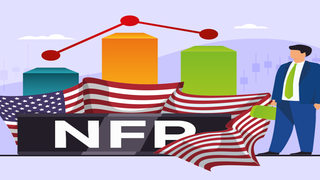
Understanding NFP and How to Trade Them
What you need to know:
Non-Farm Payrolls (NFP) is one of the most significant indicators in the financial markets. It represents the total number of paid workers in the U.S. excluding those in the farming industry, government employees, private households, and non-profit organizations. Released monthly by the U.S. Bureau of Labor Statistics, the NFP report is a key gauge of economic health. For traders, the NFP announcement is often a high-volatility event that can present both opportunities and risks.
Why NFP Matters
The NFP report gives insight into the U.S. economy’s employment trends, which in turn affects consumer spending, business investment, and economic growth. Changes in employment figures can signal shifts in the economy that might influence Federal Reserve policy decisions regarding interest rates. Given its potential impact on monetary policy, the NFP report is closely watched by traders who speculate on currencies, indices, and commodities.
Trading Strategies for NFP
Successfully trading the NFP requires a good understanding of the market, a solid strategy, and the ability to manage risk. Here’s how to trade using an NFP release:
1. Know the Expectations
In the days leading up to the NFP release, market analysts and economists provide their forecasts for the data. These estimates are compiled by financial news outlets and give traders a benchmark to compare the actual results. If the actual NFP figure significantly deviates from these expectations, it can lead to sharp movements in the markets.
How to use this: Monitor the consensus forecast, as well as the range of expectations, and compare them with the previous month's data. This helps in setting your expectations for potential market reactions.
2. Plan Your Entry
Volatility spikes following the release of the NFP report can be both an opportunity and a threat. If you plan to trade the event, it's crucial to have an entry strategy that accounts for potential price whipsaws.
Options include:
- Pre-NFP Positioning: Taking a position before the release based on your anticipation of the data. This is a high-risk, high-reward strategy and should only be considered if you have strong conviction and can manage the risks.
- Wait and See: This approach involves waiting for the report to be released and then entering the market based on the initial reaction. This can help avoid getting caught on the wrong side of a volatile move.
3. Consider the Bigger Picture
While the NFP number is important, it’s not the only data point in the report. Other elements, such as the unemployment rate and average hourly earnings, can also influence market reactions. A strong headline NFP number combined with rising wages might suggest robust economic growth, which could lead to expectations of higher interest rates. Conversely, a strong job number with stagnant wage growth might dampen inflation expectations.
How to use this: Analyze the full report, not just the headline number. Look for alignment between NFP, unemployment rates, and wage data to gauge the broader economic implications.
4. Use Technical Analysis
Technical analysis can help you identify key levels to watch before, during, and after the NFP release. Support and resistance levels, trend lines, and moving averages can act as guides for potential price movements.
Focus on:
- Support and Resistance: Identify key levels where price might react significantly.
- Price Patterns: Patterns such as flags, triangles, or head and shoulders might suggest potential breakout or reversal points.
5. Manage Your Risk
Given the potential for large and rapid price swings, risk management is critical when trading NFP. Without proper risk control, a single trade could lead to significant losses.
Key risk management tools:
- Stop Loss Orders: Set a stop loss to limit your potential downside. Be mindful that volatility can cause slippage, where your stop loss might be executed at a worse price than expected.
- Position Sizing: Trade smaller positions during high volatility events to reduce risk. This allows you to withstand adverse movements without compromising your trading account.
6. Post-NFP Analysis
Once the initial volatility subsides, markets may retrace or continue in the direction of the initial move depending on the broader sentiment. It’s important to monitor how the market digests the information over the next few hours or days.
Actions to consider:
- Re-enter Trades: If you sat out the initial reaction, consider entering a trade once the market has established a clear direction.
- Reassess the Market: Review the NFP report in the context of other economic data released that week to determine if the trend is sustainable.
Example of a Simple NFP Trading Strategy
- Preparation: A day before the NFP release, check the forecasted numbers and market sentiment. Identify key technical levels on the charts.
- Set Alerts: Place alerts around key support and resistance levels identified in your analysis.
- Execution: Wait for the NFP release. If the actual number is significantly higher or lower than expected, wait for the market's initial reaction. If the market breaks through a key technical level, consider entering a trade in the direction of the breakout.
- Stop Loss and Take Profit: Set a stop loss just outside the range of recent price action to avoid being stopped out by normal market noise. Set a take-profit level based on the next technical level or a predefined risk-reward ratio.
- Post-Trade: Once the trade is executed, monitor the market closely. If the trade is moving in your favor, consider trailing your stop loss to lock in profits.
Conclusion
Trading the NFP can be highly rewarding if done with the right strategy and discipline. However, it’s essential to be aware of the risks and to use appropriate risk management techniques. By understanding the NFP report and how it influences the markets, you can develop strategies that capitalize on the increased volatility while protecting your trading capital. Each NFP release offers a new opportunity, and with careful preparation and execution, you can make these events work in your favor.
Advertorial


